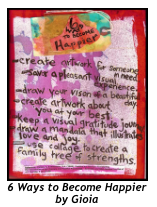April 2018
When we are working with people who are trying to experience more positivity and wellbeing, we often ask them to imagine what their lives would be like if things were the best that they could be. Where would they be? Who would they be with? What would they be doing? How would they be feeling?
Understandably, people often struggle with painting this idealized picture when they are feeling stressed out or overwhelmed. In addition, there might be a natural reticence to building up hopes when they might never be realized. In other words, why contemplate possibilities? It only leads to disappointment if they never come to fruition.
On the other hand, we want to be able to identify what it would be like if things were better. Sometimes that might start with what it’s like when it is not. That’s usually what we’re most in touch with when we’re struggling with stress anyway. We often have our clients divide a piece of paper into four columns titled “When it’s bad”, “When it’s good”, “What makes it worse”, and “What makes it better” and fill those columns out.

The last column is where we mine for what will be most critical to that person’s wellbeing. It usually contains 3-5 things which, although essential, are often surprisingly mundane. And yet it’s tweaking those that determines on which side of “better” and “worse” we are falling. Life is never stress free, so it would be unrealistic to expect that we would always stay squarely on the better side.
Therefore, we try to notice when we’re sliding towards or we’ve gotten back on the side of worse. Then we refer back to our list and implement one or two of the strategies that might tip that scale north again.
We suggest that you do that exercise and see what comes up in that last column. Here is a link to the shorter version of our handout on strategies for increasing wellbeing to help you consider which ones might be most critical to you. However, we suggest that you personalize it because it will make your list more specific and relevant to you.
And just to switch things up, we offer an alternative to our usual “positive” proscriptions. We suggest that you dive into the third column, “What makes it worse” and playfully explore what you would need to do to guarantee that you would always be stressed out, that you would never get any relief from your stress, that you would always be miserable and unhappy. Engage in what our colleague, psychologist Dan Tomasulo, calls NOT Therapy-Negatively Oriented Therapy.
Dan humorously offers a robust recipe to help ensure that you stay stuck in your misery. He outlines a series of highly effective techniques to “get you into, or help you maintain, a foul mood” including things like dwelling on missed opportunities, broken relationships, and mistakes you’ve made, being stingy, isolating in dark enclosed spaces, watching the news just before you go to bed, forgetting about the power of now and instead ruminating and wallowing in the power of then, etc. Here is a link to Dan’s blog on NOT Therapy (you can also download it here) which he happily agreed to share with you if you needed help maintaining a state of misery.
Even though it’s tongue-in-cheek, really indulging in some wholehearted negativity sometimes allows positivity to emerge more organically. See if diving deeper for a moment into what makes it worse doesn’t help illuminate what makes it better.
Positively (and Negatively) Yours, Rebecca and Gioia
Art Directive
Divide a piece of paper into four columns “When it’s bad”, “When it’s good”, “What makes it worse”, and “What makes it better”, and fill those with all of the things that come to mind. Then, with Negatively Oriented Therapy in mind, make a collage that includes all of things that you can or would do in order to be as miserable as you could be. Next make a collage of things that make you feel better. Notice differences. If nothing else, see if it doesn’t give you a different perception of how you manage stress.
